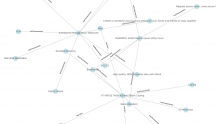广义随机森林
了解causal forest之前,需要先了解其forest实现的载体:GENERALIZED RANDOM FORESTS[6](GRF)
其是随机森林的一种推广, 经典的随机森林只能去估计label Y,不能用于估计复杂的目标,比如causal effect,Causal Tree、Cauasl Forest的同一个作者对其进行了改良。先定义一下矩估计参数表达式:
其中,(psi) 是score function,也就是measure metric,(theta) 是我们不得不去计算的参数,比如tree里面的各项参数如特征threshold,叶子节点估计值..etc, (upsilon)
则是一个可选参数。(O) 表示和计算相关的值,比如监督信号。像response类的模型,(O_i={Y_i}), 像causal 模型,(O_i={Y_i, W_i}) (W) 表示某种treatment。
该式在实际优化参数的时候,等价于最小化:
其中,(alpha) 是一种权重,当然,这里也可以理解为树的权重,假设总共需要学习(B) 棵树:
其中,(L_b(x)) 表示叶子节点里的样本。本质上,这个权重表示的是:训练样本和推理或者测试样本的相似度,因为如果某个样本(x_i)落入叶子(L_b) ,且我们可以认为叶子节点内的样本同质的情况下,那么可以认为这个样本和当前落入的tree有相似性。
当然,按照这个公式,如果(L_b) 很大,说明进入这个叶子的训练样本很多,意味着没划分完全,异质性低,则最后分配给这棵树的权重就低,反之亦然。
分裂准则框架
对于每棵树,父节点(P) 通过最优化下式进行分裂:
其中,(mathcal{J}) 表示train set,分裂后形成的2个子节点标准为:通过最小化估计值与真实值间的误差平方:
等价于最大化节点间的异质性:
但是(theta) 参数比较难优化,交给梯度下降:
其中,(hat theta_P) 通过 (2) 式获得, (A_p) 为score function的梯度
梯度计算部分包含2个step:
- step1:labeling-step 得到一个pseudo-outcomes
- step2:回归阶段,用这个pseudo-outcomes 作为信号,传递给split函数, 最终是最大化下式指导节点分割
以下是GRF的几种Applications:
Causal Forest
以Casual-Tree为base,不做任何估计量的改变
与单棵 tree 净化到 ensemble 一样,causal forest[7] 沿用了经典bagging系的随机森林,将一颗causal tree 拓展到多棵:
其中,每科子树(hat tau) 为一颗Casual Tree。使用随机森林作为拓展的好处之一是不需要对causal tree做任何的变换,这一点比boosing系的GBM显然成本也更低。
不过这个随机森林使用的是广义随机森林 , 经典的随机森林只能去估计label Y,不能用于估计复杂的目标,比如causal effect,Causal Tree、Cauasl Forest的同一个作者对其进行了改良,放在后面再讲。
在实现上,不考虑GRF,单机可以直接套用sklearn的forest子类,重写fit方法即可。分布式可以直接套用spark ml的forest。
self._estimator = CausalTreeRegressor( control_name=control_name, criterion=criterion, groups_cnt=groups_cnt) trees = [self._make_estimator(append=False, random_state=random_state) for i in range(n_more_estimators)] trees = Parallel( n_jobs=self.n_jobs, verbose=self.verbose, **_joblib_parallel_args, )( delayed(_parallel_build_trees)( t, self, X, y, sample_weight, i, len(trees), verbose=self.verbose, class_weight=self.class_weight, n_samples_bootstrap=n_samples_bootstrap, ) for i, t in enumerate(trees) ) self.estimators_.extend(trees) CAPE: 适用连续treatment 的 causal effect预估
Conditional Average Partial Effects(CAPE)
GRF给定了一种框架:输入任意的score-function,能够指导最大化异质节点的方向持续分裂子树,和response类的模型一样,同样我们需要一些估计值(比如gini index、entropy)来计算分裂前后的score-function变化,计算估计值需要估计量,定义连续treatment的估计量为:
估计量参与指导分裂计算,但最终,叶子节点存储的依然是outcome的期望。
此处的motivation来源于工具变量和线性回归:
此处我们假设(x)是treatment,y是outcome, (w) 作为一个参数简单的描述了施加treatment对结果的直接影响,要寻找到参数我们需要一个指标衡量参数好坏, 也就是loss, 和casual tree一样,通常使用mse:
为了最快的找到这个w,当然是往函数梯度的方向, 我们对loss求偏导并令其为0:
(2) 代入 (1) 式可得:
可简化得参数w是关于treatment和outcome的协方差/方差。至于(xi) , 似乎影响不大。
refs
- https://hwcoder.top/Uplift-1
- 工具: scikit-uplift
- Meta-learners for Estimating Heterogeneous Treatment Effects using Machine Learning
- Athey, Susan, and Guido Imbens. "Recursive partitioning for heterogeneous causal effects." Proceedings of the National Academy of Sciences 113.27 (2016): 7353-7360.
- https://zhuanlan.zhihu.com/p/115223013
- Athey, Susan, Julie Tibshirani, and Stefan Wager. "Generalized random forests." (2019): 1148-1178.
- Wager, Stefan, and Susan Athey. "Estimation and inference of heterogeneous treatment effects using random forests." Journal of the American Statistical Association 113.523 (2018): 1228-1242.
- Rzepakowski, P., & Jaroszewicz, S. (2012). Decision trees for uplift modeling with single and multiple treatments. Knowledge and Information Systems, 32, 303-327.
- annik Rößler, Richard Guse, and Detlef Schoder. The best of two worlds: using recent advances from uplift modeling and heterogeneous treatment effects to optimize targeting policies. International Conference on Information Systems, 2022.




![[python] 基于PyWaffle库绘制华夫饼图](http://www.itfaba.com/wp-content/themes/kemi/timthumb.php?src=http://www.itfaba.com/wp-content/uploads/2024/05/20240501_6631b60b83c2c.png&w=218&h=124&zc=1)
